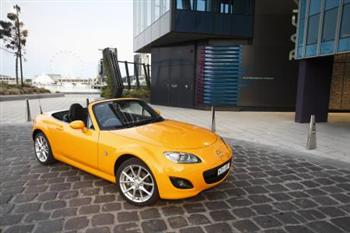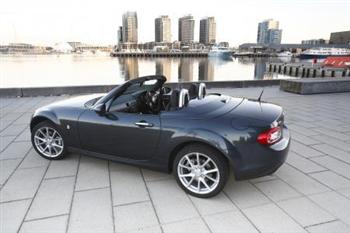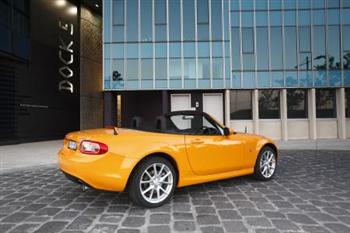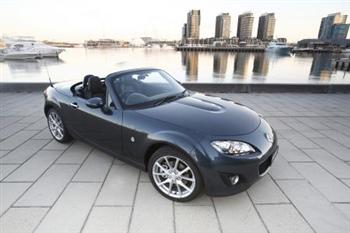|
Home | News | Road Tests | ||||||||||||||||||||||
2009 Mazda MX-5 Released
Mazda MX-5 offers roadster driving at its best. Its original concept has been so successful that Mazda has never changed it: affordable to buy and use, light weight, Jinba Ittai 'one-with-the-car' handling, and classic roadster looks. The third generation launched in 2005 was developed with a strict 'gramme strategy', keeping weight the same while offering an even stiffer body and more equipment. This year Mazda introduces a facelift of the current third generation MX-5 with enhancements that will attract even more people to this unique roadster. This year marks the 20th anniversary of the Mazda MX-5, which is listed in the Guinness Book of World Records as the best selling open two-seat sports car ever. More than 855,000 MX-5s have been produced since launch in 1989, including more than 15,000 units that have been sold in Australia (to December 2008). In 2006, Mazda launched the MX-5 Roadster Coupe with a power retractable hardtop while keeping the unique roadster styling. The hardtop weighs only 37 kg including its folding mechanism and takes no additional luggage space, ensuring the same ideal 50:50 weight distribution and the same boot volume (150 litres) as the soft top. The facelift model of the third-generation MX-5 carries forward the popularity of this expanded line-up. Both bodystyles have a design enhanced to be more dynamic and strong, and harmonised with Mazda's next generation line-up. Both MX-5 Soft-top and Roadster Coupe deliver an evolution of Jinba Ittai driving fun and have more equipment. With these updates the MX-5 Soft-top will continue to appeal to customers looking for a pure roadster experience. The retractable hard top appeals to customers looking for a more coupe-like and premium roadster experience. To underscore its upgrade nature, the facelift Roadster Coupe now has special exterior design details and a quieter cabin than the original Roadster Coupe with the top up. Mazda MX-5- Three Generations of Success It was such a big step in the early 1980s to even consider building a roadster (which had pretty much died off a decade earlier) that it took nearly a decade to realise it. In 1986, after several years of careful evaluation, Mazda decided to build a compact, light weight, front-midship engine, rear-wheel drive roadster. On 9th February, 1989, the first generation Mazda MX-5 was launched at the Chicago Motor Show in USA. The MX-5 had all the ingredients of a perfect roadster: it was light weight, nimble and well-balanced and offered pure driving sensations. The MX-5's cute looks and pop-up headlights made it an instant hit with roadster enthusiasts around the world. By 1993, Mazda's friendly little MX-5 triggered renewed interest in two-seat roadsters and was on its way to becoming a desired sports car. That year, Mazda introduced a new 1.8-litre engine with more power. The second generation MX-5 was launched in 1998, refining the original formula. At the 2005 Geneva Motor Show, Mazda introduced the third-generation MX-5 Roadster. This version was the roomiest, best-equipped, most fun to drive and coolest-looking roadster Mazda had ever made. But enthusiasts of the roadster didn't have to wait long for more to celebrate. In 2006, Mazda expanded the line-up with the Roadster Coupe, which had a power retractable hardtop and a distinctive look all of its own.
Mazda MX-5 Roadster Coupe The MX-5 Soft-top was joined by a retractable hard top version in 2006, called the Roadster Coupe. Since then it has made open-top fun available to a new customers looking for the practicality and comfort that a hard top roadster offers. Its unique look and retractable hard top made it a 'hit' from the start. The top opens and closes in just 12 seconds - among the fastest in the segment - and does not take away any boot space when open. The retractable hard top weighs only 37 kg, including its folding mechanism. Thanks to this the MX-5 Roadster Coupe is just as agile and dynamic as the MX-5 soft top, maintaining its ideal 50:50 weight distribution. The boot volume of 150 litres is also identical. For its first facelift, engineers focused on enhancements that make the MX-5 Roadster Coupe more appealing to its biggest fans, and to position it to be a more premium product. Updates include:
Design Expressive New Front Face The third-generation MX-5 soft top and Roadster Coupe continue a design legacy that visually communicates driving enjoyment in a unique Mazda way. They literally express Jinba Ittai, oneness between car and driver, through their compact size and roadster proportions. With the facelift, designers have given the exterior an enhanced dynamic appeal using forms that improve aerodynamic performance and set-off the Roadster Coupe with a more premium look, while refining the interior. Exterior Design The MX-5 facelift expresses Mazda's next generation design DNA while retaining the friendly appeal for which the roadster is known. A single front fascia bumper is introduced that is more visually aggressive and aerodynamically efficient. It adopts the typical Mazda five-point grille, now framed by newly designed headlamps that slant inward towards the top points of the grille. The turn indicator inner lenses at the outer corners of the each headlamp are now white for a quality look. New triangular fog lamp bezels at the lower edges of the integrated bumper are imbedded deeply in the fascia surface with thick framing for a strong, sporty look. The facelift's silhouette is characterised by new side sills and garnishes, which are more sculptured and protrude further than before. These form strong character lines that highlight the rear wheel wells for an enhanced sporty crouch. The rear end is instantly recognisable as the MX-5, but with subtle design changes to give it a stronger appearance. The facelift's rear bumper is more integrated into the body. It slants inward and upward to be flush with the bottom of the rear lamps, which highlights bumper thickness. The lower portion of the rear mudguards are more sculptured and extended downward, as they are at the front, and new rear combination lamps are introduced that have a sparking 'U' shape when illuminated by headlamps of following vehicles, for an enhanced sense of quality. Advanced Aerodynamics The front end design not only looks more dynamic and strong, it supports the facelift's stability at speed by being extremely aerodynamic. New body features to achieve this are:
Interior Design- Classy, easy to live with The roadster spirit of the exterior is reflected in the cockpit. The facelift inherits the clean forms of the original third generation model, and updates this with new materials, detailing and colour combinations for a stronger sense of quality. The transversal decorative panel on the dashboard has been changed from piano black to dark silver. The meter graphics are now placed further apart for better readability, and the tripmeter/odometer in the lower centre of the cluster is now a red-backlit LCD. In the centre stack, the three large air conditioning knobs also have new silver-look rings, and more silver is added to the assist grips on the doors, which match the rings of the driver cluster for a fresh, coordinated look. Mazda's latest factory-installed audio system, also used in the Mazda 6, has a new, cleaner look as well. A soft pad is added to the lid of the centre console's storage box and to the armrests on Touring and Roadster Coupe models to improve comfort. The seats were modified to further strengthen feeling of oneness between car and driver. Larger side bolsters and revised cushion surfaces ensure optimal side support and a stronger sense of the seats wrapping around the occupants. Two-tone RECARO sports seats with leather and perforated Alcantara® are now available as part of the MX-5 Roadster Coupe Sports Pack. Eight colours, three all-new Eight body colours are available with the MX-5 facelift, including three new colours: Sunset Yellow, Aluminium Metallic and Metropolitan Grey. The Aluminium Metallic colour contains aluminium particles that diffuse light and cause diverse kinds of reflections and shadow, depending on light conditions. Carry-over colours are True Red, Copper Red Mica, Stormy Blue Mica, Marble White and Brilliant Black. Mazda does not charge extra for metallic or mica colours.
Powertrains Enhanced Performance Feel The MX-5 facelift inherits the third generation's lively petrol engine and precise shifting manual transmission, with some major updates to enhance the roadster experience. Engineers changed the 2.0-litre petrol to give it a stronger performance feel, retuned all engines to use less fuel and produce less CO2, and finessed the six speed Activematic. 2.0-litre engine and six-speed manual transmission Higher Rev-Limit and Engine Updates On the surface it appears as though the 2.0 litre petrol engine has been carried over without change. But that would underplay the dozens of changes and modifications that realise a more responsive drive and fuel economy improvement. The 2.0 litre petrol with six-speed manual transmission produces 118 kW of power and 188 Nm of torque. While maximum torque is still produced at 5,000 rpm, maximum power is now reached at 7,000 rpm (300 rpm higher than before), and the rev-limit is now at 7,500 rpm on manual models (500 rpm higher than before) making sporty driving even more exciting. A forged crankshaft is also introduced to ensure rigidity at higher engine speeds. New, as well, are fully floating pistons with higher pin-boss reliability, revised valve springs that suppress valve 'bounce' that can occur at high revs and higher durability materials for the connecting rod bearings. Together with the higher rev-limit, these modifications give the 2.0 litre engine and six speed manual transmission combination an even better performance feel than before. The six speed manual transmission developed by Mazda features optimised synchronisation that allows shifting gears even more quickly and smoothly than before. The six speed manual transmission's third-to-fourth gear synchromesh diameter is increased by 6 mm, synchroniser cone specifications for all gears have been revised and carbon used on some of the meshing surfaces of the first through fourth gear synchroniser cones. Performance with the six speed manual transmission is improved, with the MX-5 soft top accelerating from 0-100 km/h in 7.6 seconds (prev: 7.8). The MX-5 Roadster Coupe can reach a top speed of 218 km/h. A More Exciting Engine Sound All Mazda MX-5 facelift versions offer a sportier engine sound. Mazda engineers restructured the sound elements of the facelift model - such as the surge tank, the intake ducts and the exhaust system - to give an even sportier and more distinct engine sound that varies noticeably according to driving situations and pedal input. For the 2.0 litre petrol with six-speed manual transmission, a newly developed Induction Sound Enhancer (ISE) is added for an even sportier driving feel. This component delivers a stronger sound response and a more varied tone by amplifying the pulse sounds provided when the throttle valve opens and air is aspirated. This sound is transmitted to the dash panel through the air, but also to the dashboard, the outside dash top and the windshield frame through a special duct. The sound transmission to the outside dash top provides an even more intense sound when the roof is open. Further Enhanced Fuel Efficiency Despite an increase in performance feel for the 2.0 litre powertrain, and the same power and torque output as before, the MX-5 facelift 2.0 litre engine with manual transmission and with Activematic transmission uses less fuel and produces fewer CO2 emissions than before. In both cases fuel economy is rated at 8.1 litres per 100 km (six-eight per cent less than before) and produces 192 g/km of CO2. Six Speed Activematic Transmission The 2.0 litre engine is available with a six-speed Activematic transmission. It includes a direct Activematic (DAM) function that allows manual gear shifts using paddles on the steering wheel without changing into manual-shift mode beforehand. This gives a sporty driving feel and is especially practical on a downhill slope, when cornering or when passing a vehicle. When the transmission's control system determines that the lower gear is no longer needed, it reverts to normal operation. The Activematic® also features an Active Adaptive Shift (AAS) function that monitors the road's gradient and curviness, accelerator and brake pedal inputs, rate of vehicle acceleration and how the roadster is being steered, to select optimal shifts. This delivers linear, dynamic performance in line with driver intentions and results in fun and sporty driving with all the comfort and convenience an automatic affords. When combined with the six speed Activematic transmission, the 2.0 litre engine delivers 118 kW at 6,700 rpm and 188 Nm at 5,000 rpm; its rev-limit is at 7,000 rpm. This powertrain uses 8.1 litres of fuel and produces 191 g/km of CO2. Chassis and Safety Evolution of Jinba Ittai With its ideal weight distribution, compact dimensions, superior steering and chassis systems, the MX-5 offers pure roadster fun. For the facelift version, Mazda has evolved the roadster's unique Jinba Ittai 'one-with-the-car' feel by enhancing its legendary nimbleness and controllability even further.
Evolving Jinba Ittai The third generation MX-5 was developed with the so called Jinba Ittai philosophy in mind. The expression can be traced back to the Yabusame ritual, where an archer shoots an arrow at a target while riding a horse. To hit the bull's eye, the rider and horse have to act as one - otherwise the arrow will miss its mark. Applied to the MX-5, Jinba Ittai means oneness between car and driver - the MX-5 reacts instantly to the driver's commands. For the facelift version of the third generation model, Mazda engineers enhanced Jinba Ittai even further. The 2.0-litre engine's rev-limit, when matched to the smooth shifting six speed manual transmission, is higher and the engine now sounds even sportier. The suspension was revised to improve roll performance and give a more natural feel when cornering. Advanced aerodynamics, especially at the front end, enhance stability and predictability at high speeds. Together, these updates make the New MX-5 even more thrilling to drive. Chassis Updates The third generation was launched with a stiffer and lighter body shell than the second generation MX-5 it replaced. The facelift version carries on this tradition: it has high flexural and torsional rigidity and is roughly the same light weight as the original model, with an ideal 50:50 weight distribution. The Mazda MX-5 retains the double-wishbone front and multilink rear suspension systems, along with the MX-5's front-midship engine, rear-wheel drive layout with a stiff powerplant frame in the transmission tunnel. This forms a rigid connection between the transmission and the rear differential to brace the chassis and suppress chassis deformation during sporty driving. MX-5 models equipped with the six speed manual transmission are fitted with a limited slip differential (LSD) that ensures optimum traction under all driving conditions. For the facelift, Mazda engineers revised the front suspension by altering the ball joints' vertical pivot position, which lowered the height of the front roll centre by 26 mm. This decreases fluctuations in vertical load on the outer wheel when cornering. As a consequence, roll movement caused by steering input is now more linear. Moreover, the R&D team fine-tuned the suspension settings to ensure that the MX-5 facelift reacts even more precisely to driver commands, and realised a higher quality ride by making yaw and roll feel more natural. Together, these modifications translate into an enhanced 'Jinba Ittai' feeling of control, especially when cornering. Safety The MX-5 facelift has the same outstanding active and passive safety package as the original third generation model. Its brake system with 290 mm ventilated front discs and 280 mm solid rear discs delivers great brake pedal response and deceleration performance. Dynamic Stability Control (DSC) and Traction Control System (TCS) are standard on all models. Passive safety includes a high-tensile steel cabin, ultra high tensile roll-over brace bars in the A-pillars, side impact protection and strong body floor cross members. Front airbags are standard, as are special two-chamber side airbags that help protect both the thorax and the head. These are integrated into the seatback and are activated by a common gas generator and inflator, which inflate both chambers faster than some single-chamber systems, for excellent side protection. Comfort, Equipment and Convenience Quieter and More Comfortable The MX-5 is not only for driving with the top down. The MX-5 facelift introduces measures that make both the soft-top and the Roadster Coupe quieter and more comfortable to be in when driving with the top up. Improved Cabin Quietness For improved cabin quietness on both body styles, engineers adopted stiffer door modules for less vibration at the side of the car, reduced the level of wheel resonance and used additional sound-insulation materials. The Roadster Coupe adds comprehensive measures to suppress road noise and support its premium character. The front suspension cross member is filled with urethane to lower the transmission of road noise to the cabin, and reinforcements were added to the No. 2 cross member. Vibration induced noise is also suppressed by the addition of damping material to the front-most section of the roof. Taken together, these measures insulate passengers of the Roadster Coupe better from low frequency road noise and bothersome high frequency sounds. As a result, the interior noise of the MX-5 Roadster Coupe facelift at 60 km/h on a coarse road is 2.7 dB quieter than the original model. Comfort and Ease-of-Use The cabin of the MX-5 facelift model offers enhanced comfort. The door cup holders, for instance, do not protrude into the cabin anymore, which provides more space to the occupants' legs. The armrests and the floor console lid in Touring and Roadster Coupe models have new pads for better comfort. The Roadster Coupe's retractable hard top is also one of the easiest to use. It opens and closes in just 12 seconds - one of the fastest of its kind - and does not reduce boot space when retracted. The soft top opens and closes manually in just a few seconds. The boot itself inherits the original model's size of 150 litres and can be opened easily by pushing a button either on the dashboard or on the remote key. Convenience and Equipment The Mazda MX-5 facelift has enhanced small-item storage, and new features and equipment that make the car easy to use. The storage tray in front of the shift lever is now large enough to hold a mobile phone or MP3 player, and a rubber mat keeps stored items in place. The console's two cupholders now have a new removable partition that allows the use of either two cup holders or one large storage space, and rubber mats for better support and rattling noise prevention. New door pockets are introduced as well. Two practical storage boxes behind the seats (one box in the Roadster Coupe) are carried over from the original model.
Value-packed with features and equipment The Mazda MX-5 facelift has a long list of standard equipment, including remote central locking, air-conditioning, six-speaker, six-disc stereo with AUX-in jack, cruise control, power windows and mirrors, tilt-adjustable steering, driver's seat height adjust, and leather-trim on the gear shifter, steering wheel and handbrake lever. The Mazda MX-5 doesn't skimp on active or passive safety with driver and passenger front and side airbags, Dynamic Stability Control (DSC ) with Traction Control System (TCS), and antilock brakes, 17-inch alloy wheels and Limited Slip Differential (on manual models). The MX-5 Touring adds leather sports seats, drilled alloy pedals and a 200W Premium Bose® seven-speaker sound system. The MX-5 Roadster Coupe includes all the features and equipment of the MX-5 Touring, and adds an electrically-retracting hard top which stows in just 12 seconds, and without impact on luggage space, to give the best of coupe and convertible motoring. The range-topping MX-5 Roadster Coupe with optional Sports Pack adds RECARO sports bucket seats and striking 17-inch BBS alloy wheels. The MX-5 Touring and MX-5 Roadster Coupe (with or without Sports Pack) can be optioned with Mazda's six-speed Activematic transmission, which includes steering wheel-mounted paddle shifters, for $2,200. Other options include a Bluetooth® phone system with voice recognition for hands free telephoning, which automatically mutes audio output during phone calls. Premium Bose® Audio System - Updated for the New Mazda MX-5 Bose® and Mazda worked together to develop a refined premium audio system exclusively for the MX-5 facelift. It uses seven speakers, digital sound processing and six equaliser channels, two more than the previous system. Almost every speaker is now addressed by an individual equaliser channel which allows very precise sound tuning. The new Bose® system also uses crossover technology to differentiate the speaker's respective frequency range. The result is a more clearly defined, well-balanced sound free of distortion, even at high volume levels. AudioPilotTM 2 noise compensation technology automatically adjusts the sound to current driving conditions. While the previous AudioPilotTM compensated only interior noise, AudioPilot®2 works more precisely by adjusting to both interior noise and vehicle speed. Alcantara® is a registered trademark and owned by ALCANTARA S.p.A, Italy. | ||||||||||||||||||||||
More Mazda News ..... here About | Car Clubs | Home | News | Road Ramblings | Road Tests | Subscribe | Top Drive © 2009 All rights reserved. Next Car Pty. Ltd. |







